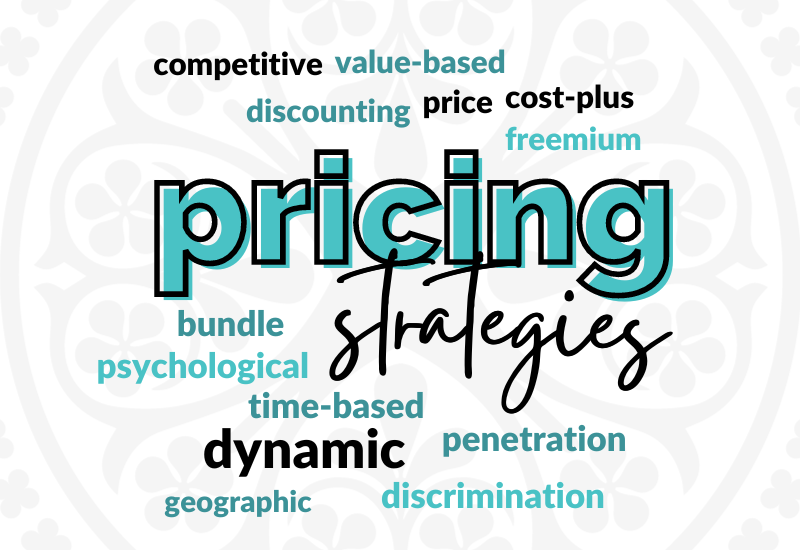
During this year's Wedding MBA event, our CEO, Corrine, took the stage to deliver a presentation on "Price Crisis." She dived into the intricate world of pricing strategies, offering florists valuable insights into the various approaches they can adopt to navigate and excel in their business. Corrine's presentation was an engaging exploration of this critical aspect of the floral industry, providing attendees with actionable strategies and valuable takeaways to enhance their pricing models and overall business success. If you could not attend, here is a step-by-step guide on the most popular pricing strategies!
1) Cost-Plus Pricing
Determine the cost of producing a product or service and then add a markup to set the price.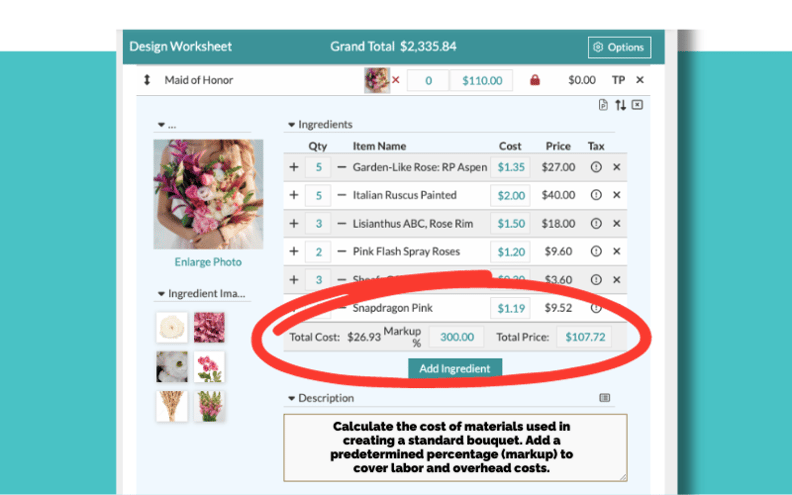 Florists can employ the Cost-Plus Pricing strategy to determine their prices by calculating the cost of floral arrangements and adding a markup. This approach is illustrated through examples of different aspects of the floral business, such as basic arrangements, custom designs, delivery services, seasonal specials, corporate contracts, and subscription services. By utilizing Cost-Plus Pricing, florists can ensure they cover their expenses and generate a profit, with the markup percentage being flexible based on factors like competition and local market conditions.
Florists can employ the Cost-Plus Pricing strategy to determine their prices by calculating the cost of floral arrangements and adding a markup. This approach is illustrated through examples of different aspects of the floral business, such as basic arrangements, custom designs, delivery services, seasonal specials, corporate contracts, and subscription services. By utilizing Cost-Plus Pricing, florists can ensure they cover their expenses and generate a profit, with the markup percentage being flexible based on factors like competition and local market conditions.
2) Value-Based Pricing
Set prices based on the customer's perceived value of the product or service. This strategy often involves higher prices for premium or unique offerings.
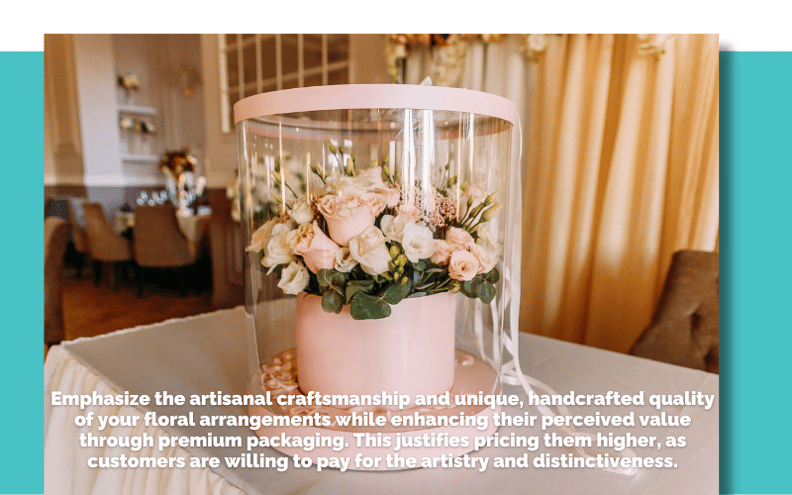 Value-based pricing in the floral business enables florists to set prices based on the perceived value of their products and services to customers. This strategy involves charging higher prices for premium or unique offerings, such as exclusive flower varieties, custom designs, luxury packaging, seasonal collections, event packages, fast delivery, professional design services, artisanal touch, exclusive partnerships, and quality guarantees. By employing value-based pricing, florists can cater to customer preferences and maximize revenue while maintaining a strong brand image.
Value-based pricing in the floral business enables florists to set prices based on the perceived value of their products and services to customers. This strategy involves charging higher prices for premium or unique offerings, such as exclusive flower varieties, custom designs, luxury packaging, seasonal collections, event packages, fast delivery, professional design services, artisanal touch, exclusive partnerships, and quality guarantees. By employing value-based pricing, florists can cater to customer preferences and maximize revenue while maintaining a strong brand image.
3) Competitive Pricing
Set prices in line with or slightly below competitors' prices. This strategy is common in industries with many similar products.
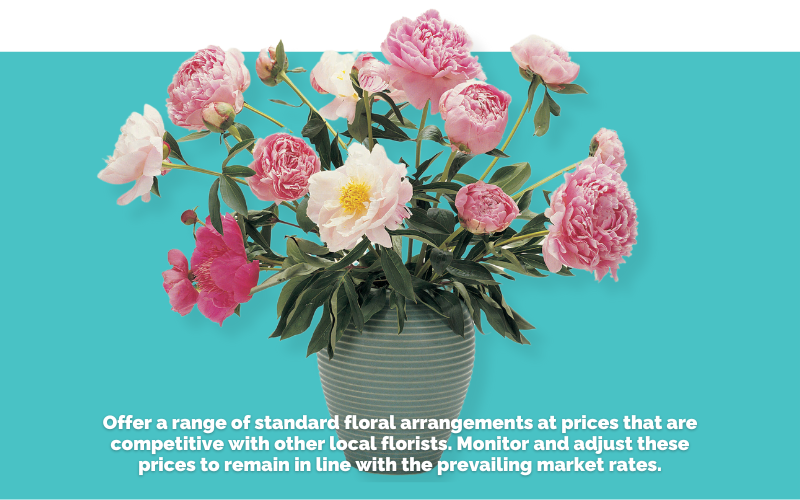 Competitive Pricing is a strategy employed by florists to set prices in line with or slightly below competitors' prices. This strategy is commonly used in industries with similar products, such as the floral industry. Florists can implement this strategy by offering standard floral arrangements at competitive rates, aligning with local market trends, and using price-matching policies and special promotions to attract cost-conscious and price-sensitive customers. Keeping delivery fees competitive, providing bulk discounts, creating loyalty programs, and maintaining an online price comparison feature on their website can also help. Regular market research and emphasizing quality and freshness as a competitive advantage are crucial components of this strategy. However, it's essential to balance competitive pricing with maintaining profitability and offering added value to stand out in the market.
Competitive Pricing is a strategy employed by florists to set prices in line with or slightly below competitors' prices. This strategy is commonly used in industries with similar products, such as the floral industry. Florists can implement this strategy by offering standard floral arrangements at competitive rates, aligning with local market trends, and using price-matching policies and special promotions to attract cost-conscious and price-sensitive customers. Keeping delivery fees competitive, providing bulk discounts, creating loyalty programs, and maintaining an online price comparison feature on their website can also help. Regular market research and emphasizing quality and freshness as a competitive advantage are crucial components of this strategy. However, it's essential to balance competitive pricing with maintaining profitability and offering added value to stand out in the market.
4) Penetration Pricing
Set a low initial price to gain market share or penetrate a new market quickly. Prices may be raised later once a customer base is established.
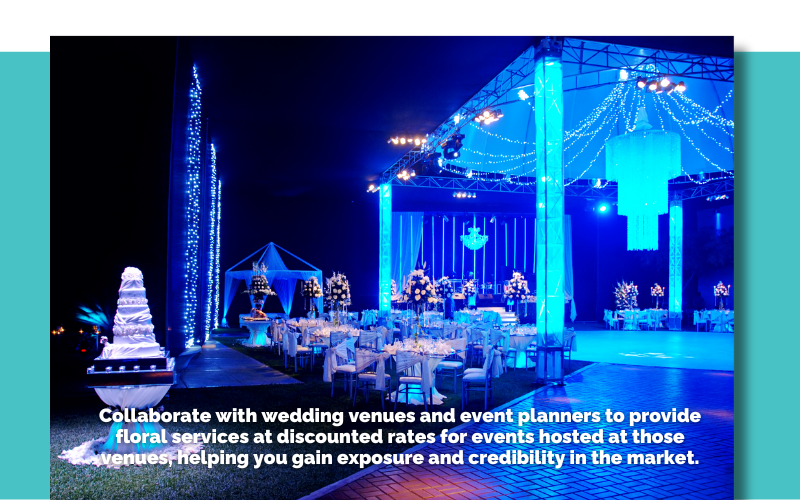
Wedding and event florists can employ a Penetration Pricing strategy to establish their presence in the competitive wedding and event industry. This involves initially offering competitive pricing to attract couples planning events in a new market. Strategies for implementing this approach include special promotions, collaborations for discounts, all-inclusive packages, early booking discounts, and referral programs to expand the customer base. Participating in local events and using social media campaigns can also help. As the business gains recognition and secures a customer base, pricing can be adjusted to reflect experience, expertise, and market positioning while gradually increasing it.
5) Psychological Pricing
Set prices just below a round number (e.g., $9.99 instead of $10) to create a perception of a better deal.

Wedding and event florists can employ Psychological Pricing to create the perception of a better deal for their services by setting prices just below round numbers. This strategy involves various tactics, such as pricing basic packages at $999, using figures ending in $0.99 for add-on services and per-item pricing, and offering discounts and limited-time deals with prices ending in $0.99. Implementing this strategy in an online store can capture the attention of cost-conscious customers. Setting initial deposits and booking fees slightly below round numbers can encourage commitment, and offering customization options with prices just under the nearest rounded figure can give customers a sense of choice and affordability. Psychological Pricing aims to make services appear more budget-friendly and appealing to price-conscious clients, even if the difference is minimal. However, it's important to ensure that the pricing remains competitive and fair within the context of the overall value proposition.
6) Bundle Pricing
Offer products or services as a bundle at a lower total price than if purchased individually.

Bundle Pricing is a strategy that wedding and event florists can utilize to provide value to clients by offering packages of products or services at a lower total price than individual purchases. For example, florists can enhance their appeal by presenting a range of bundled packages for weddings and events, such as Wedding Flower Packages, Event Decor Packages, Ceremony and Reception Packages, Seasonal Decor Packages, Destination Wedding Packages, and Customization Options to accommodate different budgets and styles. These packages often include additional services like delivery and setup, and some may involve collaborations with photographers for combined services. Bundle Pricing benefits both florists and clients, offering cost savings and convenience while potentially increasing the average transaction value for the florist and simplifying the decision-making process for clients planning events.
7) Dynamic Pricing
Adjust prices in real-time based on demand, customer behavior, or external market conditions. Common in e-commerce and travel industries.
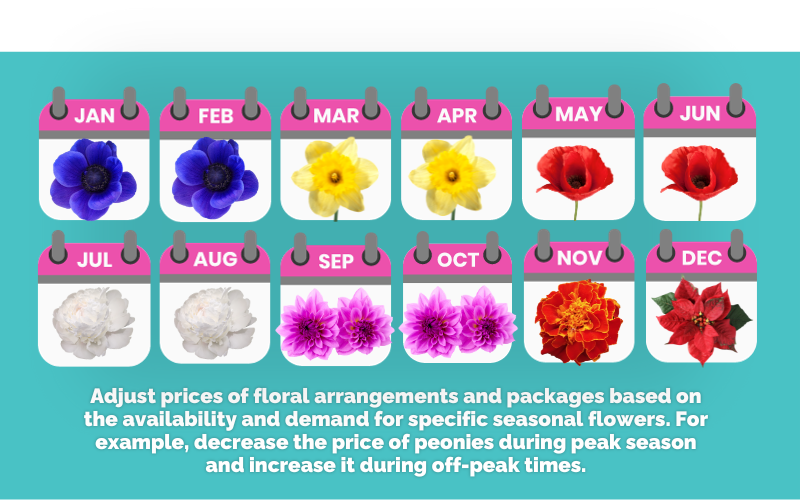 Dynamic Pricing, a strategy commonly seen in e-commerce and travel, can also be effectively applied by wedding and event florists. This approach involves adjusting real-time prices based on various factors to optimize revenue. Florists can use Dynamic Pricing to consider seasonal flower demand, event date and time, venue locations, package customization, last-minute booking discounts, customer behavior, inventory availability, competitor pricing, weather conditions, and real-time sales and demand data. These strategies enable florists to tailor prices to meet customer needs and maximize profitability. However, maintaining trust and positive customer relationships is crucial to ensuring transparency in pricing and clear communication with clients.
Dynamic Pricing, a strategy commonly seen in e-commerce and travel, can also be effectively applied by wedding and event florists. This approach involves adjusting real-time prices based on various factors to optimize revenue. Florists can use Dynamic Pricing to consider seasonal flower demand, event date and time, venue locations, package customization, last-minute booking discounts, customer behavior, inventory availability, competitor pricing, weather conditions, and real-time sales and demand data. These strategies enable florists to tailor prices to meet customer needs and maximize profitability. However, maintaining trust and positive customer relationships is crucial to ensuring transparency in pricing and clear communication with clients.
8) Freemium Pricing
Offer a basic version of a product or service for free and charge for premium features or upgrades.
 Freemium Pricing is not typically used in the wedding and event florist industry, given the nature of their services. However, some florists may adapt elements of this strategy for related services and products. For instance, they can offer free initial consultations while charging for premium detailed planning and design consultations. Providing free basic floral arrangement templates and charging for personalized designs, hosting low-cost floral workshops with advanced paid options, and developing free basic online planning tools with premium features can add value. Introducing budget-friendly floral packages alongside premium options caters to diverse budgets, and offering limited-time free trials for select floral services can lead to upselling premium event services. While not a common approach, these examples illustrate how wedding and event florists can provide a sample of their services at low or no cost to attract potential clients and promote premium offerings.
Freemium Pricing is not typically used in the wedding and event florist industry, given the nature of their services. However, some florists may adapt elements of this strategy for related services and products. For instance, they can offer free initial consultations while charging for premium detailed planning and design consultations. Providing free basic floral arrangement templates and charging for personalized designs, hosting low-cost floral workshops with advanced paid options, and developing free basic online planning tools with premium features can add value. Introducing budget-friendly floral packages alongside premium options caters to diverse budgets, and offering limited-time free trials for select floral services can lead to upselling premium event services. While not a common approach, these examples illustrate how wedding and event florists can provide a sample of their services at low or no cost to attract potential clients and promote premium offerings.
9) Price Discrimination
Charge different prices to different customer segments based on factors like location, age, or purchasing history.
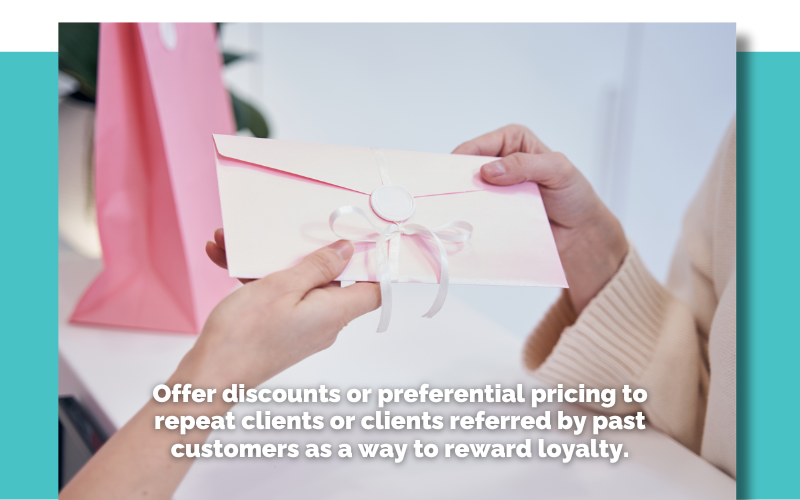 Price Discrimination, a pricing strategy that can be challenging for wedding and event florists due to the personalized nature of their services, can still be applied with some modified approaches. Strategies like Location-Based Pricing, where rates are tailored to different regions or venues, or considering event specifics like venue type, date, and guest count can impact pricing. Florists can offer tiered packages with varying levels of customization, extend past client discounts, create combo deals for multiple services, and incentivize early bookings. Distinguishing between different wedding types and offering custom discounts based on client-specific factors allows for a more flexible pricing strategy that aligns with the complexity and scale of each event and client preferences. Effective communication and transparency are crucial in successfully implementing such a strategy in the wedding and event florist industry.
Price Discrimination, a pricing strategy that can be challenging for wedding and event florists due to the personalized nature of their services, can still be applied with some modified approaches. Strategies like Location-Based Pricing, where rates are tailored to different regions or venues, or considering event specifics like venue type, date, and guest count can impact pricing. Florists can offer tiered packages with varying levels of customization, extend past client discounts, create combo deals for multiple services, and incentivize early bookings. Distinguishing between different wedding types and offering custom discounts based on client-specific factors allows for a more flexible pricing strategy that aligns with the complexity and scale of each event and client preferences. Effective communication and transparency are crucial in successfully implementing such a strategy in the wedding and event florist industry.
10) Geographic Pricing
Adjust prices based on the geographic location of the customer, accounting for factors like shipping costs and regional demand.
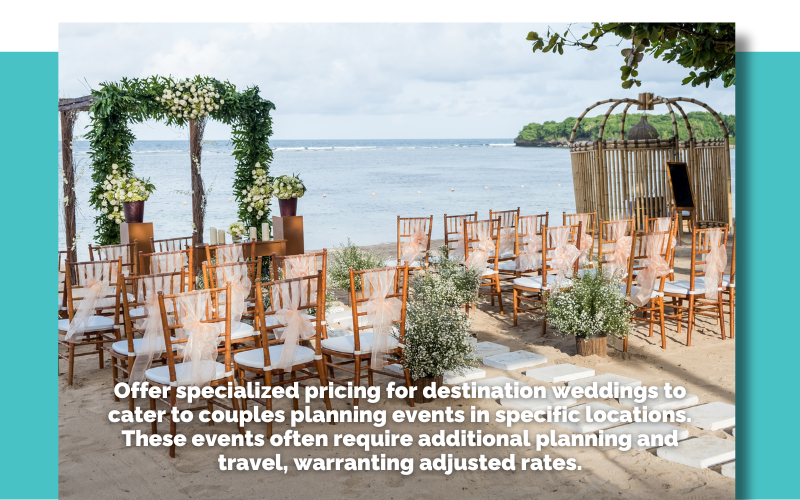
Geographic Pricing is highly relevant for wedding and event florists, enabling them to customize their pricing based on location, demand, and logistical considerations. Florists can adjust their prices in response to regional demand, charging more in consistently high-demand areas, such as popular wedding destinations. Venue location also plays a significant role, with remote or high-end venues justifying higher prices due to logistical challenges or premium demand. Flexible delivery and shipping costs should account for varying distances and expenses, while urban and rural pricing differentiation reflects demand and operating cost differences.
Specialized pricing for destination weddings accommodates additional planning and travel requirements. Considerations like seasonality and local competition are crucial, as are customized pricing proposals based on location-specific factors and tailored pricing for multi-location studios. These strategies empower florists to address the unique dynamics of different geographic areas, ensuring competitive pricing while considering variations in demand and costs. Clear communication with clients is essential to provide transparent pricing for their specific event location.
11) Time-Based Pricing
Offer discounts or promotions during specific times, such as seasonal or flash sales.
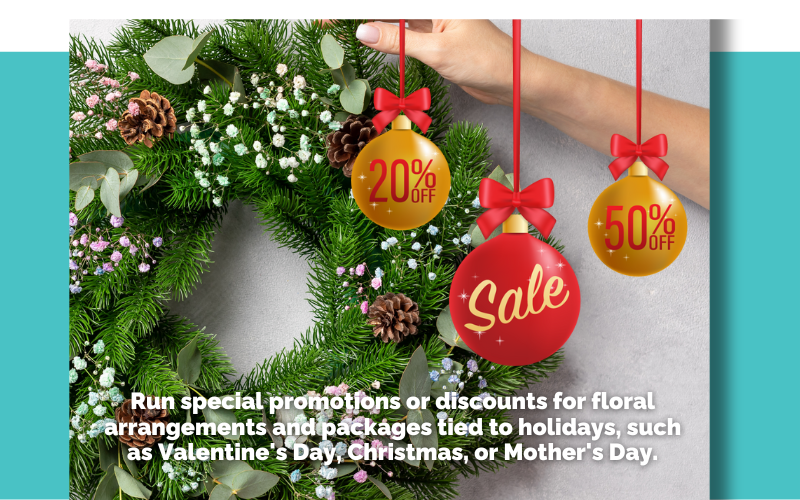
Time-based pricing is a valuable strategy for wedding and event florists to instill a sense of urgency and engage clients during specific timeframes. It involves various discount approaches like off-peak season discounts, early booking incentives, holiday and anniversary promotions, flash sales, seasonal offers, venue open house collaborations, last-minute booking discounts, deals on specific significant dates, exclusive social media promotions, and referral programs with time-limited incentives. By effectively marketing and communicating these time-sensitive offers, florists can create excitement and encourage clients to seize limited-time opportunities, enhancing business engagement and competitiveness.
12) Dynamic Discounting
Offer discounts that change based on customer behavior, cart value, or other triggers.

Dynamic Discounting can be an effective strategy for wedding and event florists to provide personalized and timely discounts based on customer behavior and triggers. Here are examples of how florists can implement this strategy:
To enhance customer engagement and encourage loyalty, wedding and event florists can employ a variety of dynamic discount strategies. These include tiered cart value discounts to reward larger orders, abandoned cart recovery initiatives through personalized discounts, behavior-based promotions triggered by customer interactions, loyalty programs with increasing rewards for repeat purchases, time-sensitive discounts based on event dates, social media engagement perks for active followers, referral discounts, subscription tiers with varying discounts, feedback and review-based discounts, and post-event follow-up discounts for future services. These tailored discounts can foster client satisfaction, repeat business, and customer advocacy, and their successful implementation relies on effective communication and a customer-centric approach.
Incorporating these pricing strategies not only helps attract new clients but also plays a crucial role in retaining existing ones. Clients appreciate florists who offer options, value their loyalty, and understand their evolving needs. As a result, businesses can establish a positive reputation, foster customer loyalty, and encourage repeat business. By effectively implementing these strategies, wedding and event florists can position themselves as client-centric, competitive, and adaptable service providers, setting the stage for long-term success and growth.
Follow Details on Instagram!